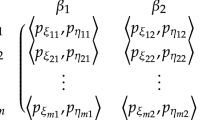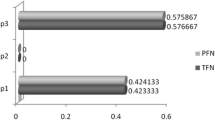Abstract
In this paper, we propose a new concept of two-person constant-sum matrix games having payoffs in the form of linguistic distribution assessments. Such types of payoffs allow the players to express their opinion in terms of a whole fuzzy set and thus, are not limited to just one single term. To establish an equilibrium solution of these kinds of matrix games, first, we define the maxmin and minmax strategies to apply in case the players play pure strategies. In mixed strategies, we develop a linguistic distribution linear programming (LDLP) approach to find the players’ mixed strategies. The method is depicted as a generalization of that traditionally used in the solution of a classical game. The applicability of defined LDLP is illustrated with the help of an example.
Access this chapter
Tax calculation will be finalised at checkout
Purchases are for personal use only
Similar content being viewed by others
References
Herrera F, Martínez L (2000) A 2-tuple fuzzy linguistic representation model for computing with words. IEEE Trans Fuzzy Syst 8(6):746–752
Herrera F, Herrera-Viedma E, Martinez L (2008) A fuzzy linguistic methodology to deal with unbalanced linguistic term sets. IEEE Trans Fuzzy Syst 16(2):354–370
Herrera F, Alonso S, Chiclana F, Herrera-Viedma E (2009) Computing with words in decision making: foundations, trends and prospects. Fuzzy Optim Decis Making 8(4):337–364
Mendel JM (2007) Computing with words and its relationships with fuzzistics. Inf Sci 177(4):988–1006
Zadeh LA (1996) Fuzzy logic = computing with words. IEEE Trans Fuzzy Syst 4(2):103–111
Zadeh LA (2001) From computing with numbers to computing with words-from manipulation of measurements to manipulation of perceptions. In: Wang pp (ed) Computing with words. Wiley Series on Intelligent Systems. Wiley, pp 35–68
Yager RR (2004) On the retranslation process in Zadeh’s paradigm of computing with words. IEEE Trans Syst Man Cybern Part B Cybern 34(2):1184–1195
Neumann JV, Morgenstern O (1944) Theory of games and economic behavior. Princeton University Press, New York
Zadeh LA (1965) Fuzzy sets. Inf Control 8:338–353
Bector CR, Chandra S, Vijay V (2004) Duality in linear programming with fuzzy parameters and matrix games with fuzzy payoffs. Fuzzy Sets Syst 146:253–269
Bector CR, Chandra S, Vijay V (2004) Matrix games with fuzzy goals and fuzzy linear programming duality. Fuzzy Optim Decis Making 3:255–269
Bector CR, Chandra S (2005) Fuzzy mathematical programming and fuzzy matrix games. Springer, Berlin
Butnariu D (1978) Fuzzy games: a description of the concept. Fuzzy Sets Syst 1:181–92
Campos L (1989) Fuzzy linear programming models to solve fuzzy matrix games. Fuzzy Sets Syst 32:275–289
Arfi B (2006) Linguistic fuzzy-logic game theory. J Conflict Resolut 50(1):28–57
Arfi B (2006) Linguistic fuzzy-logic social game of cooperation. Rationality Soc 18(4):471–537
Delgado M, Verdegay JL, Vila MA (1990) Playing matrix games defined by linguistic labels. In: Multiperson decision making models using fuzzy sets and possibility theory. Theory and decision library (series B: mathematical and statistical methods), vol 18. Springer, Dordrecht
Sahoo L (2017) Solving matrix games with linguistic payoffs. Int J Syst Assur Eng Manag 10(4):484–490
Singh A, Gupta A, Mehra A (2018) Matrix games with 2-tuple linguistic information. Ann Oper Res 287:895–910
Herrera F, Martínez L (2001) The 2-tuple linguistic computational model, advantages of its linguistic description, accuracy and consistency. Int J Uncertainty Fuzziness Knowl Based Syst 09:33–48
Abchir MA, Truck I (2013) Towards an Extension of the 2-tuple linguistic model to deal with unbalanced linguistic term sets. arXiv 1304.5897v1, 1–17
Bartczuk L, Dziwiński P, Starczewski JT (2012) A new method for dealing with unbalanced linguistic term set. In: ICAISC 2012 Part I LNCS 7267, pp 207–212
Cai M, Gong Z, Yu X (2016) A method for unbalanced linguistic term sets and its application in group decision making. Int J Fuzzy Syst 19(3):671–682
Cai M, Gong Z (2017) Group decision making using distances between unbalanced linguistic assessments. Appl Soft Comput 67:613–624
Wang JH, Hao J (2006) A new version of 2-tuple fuzzy linguistic representation model for computing with words. IEEE Trans Fuzzy Syst 14(3):435–445
Zhang G, Dong Y, Xu Y (2014) Consistency and consensus measures for linguistic preference relations based on distribution assessments. Inf Fusion 17:46–55
Barron EN (2011) Game theory: an introduction. Wiley, New Jersey
Author information
Authors and Affiliations
Corresponding author
Editor information
Editors and Affiliations
Rights and permissions
Copyright information
© 2022 The Author(s), under exclusive license to Springer Nature Singapore Pte Ltd.
About this paper
Cite this paper
Chauhan, P., Gupta, A. (2022). Matrix Games with Linguistic Distribution Assessment Payoffs. In: Saraswat, M., Sharma, H., Balachandran, K., Kim, J.H., Bansal, J.C. (eds) Congress on Intelligent Systems. Lecture Notes on Data Engineering and Communications Technologies, vol 111. Springer, Singapore. https://doi.org/10.1007/978-981-16-9113-3_56
Download citation
DOI: https://doi.org/10.1007/978-981-16-9113-3_56
Published:
Publisher Name: Springer, Singapore
Print ISBN: 978-981-16-9112-6
Online ISBN: 978-981-16-9113-3
eBook Packages: Intelligent Technologies and RoboticsIntelligent Technologies and Robotics (R0)




